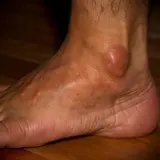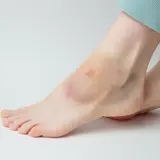Repeated irritation or trauma have been blamed for the cause of these deformities. People who wear boots frequently or those who have a bone spur (bony outgrowth) are more likely to experience these ganglions.
What are ganglion cysts?
A ganglion cyst is a tumor or swelling that occurs in the lining of a joint or tendon (the soft tissue structure that connects muscle to bone). These are sac like structures that can be found anywhere there is a joint or tendon structure. Frequently these cysts are located on the top of the foot or front of the ankle. Inside of the cyst is a thick, apple jelly like substance that is non-harmful. The location of the cyst is frequently the determining factor as to the amount of pain the person experiences. Because the cyst can become extremely firm, they are notorious for causing painful pressure when a person attempts to wear shoes. Frequently, these cysts are mistaken for bone spurs.
Ganglions account for more than one half of all of the soft tissue tumors that occur within the foot and ankle.


How to treat ganglion cysts
These cysts occur more frequently in women, and 70% occur in people between the ages of 20 and 40 years of age. These cysts have frequently been coined “Bible cysts”.
Get in touch!
Call our office if you have any questions about what we do or to schedule an appointment.
